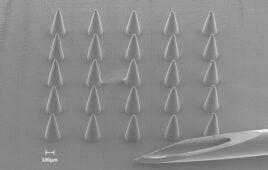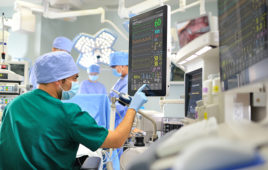Whitehead Institute researchers have created a hydrogel scaffold replicating the environment found within the human breast. The scaffold supports the growth of human mammary tissue from patient-derived cells and can be used to study normal breast development as well as breast cancer initiation and progression.
“I wouldn’t have thought it possible that these tissues could grow with such complexity and to such a size,” says Whitehead Member Piyush Gupta, who is also an assistant professor of biology at MIT. “It’s really quite remarkable.”
Breast cancer research has been largely confined to studying transformed cell lines in a dish or implanting cells from established human tumors into mice and other animal models of the disease. Although these models provide some insight into a cancer’s machinations at the cellular level, they fall short when investigating cancer initiation and progression within human tissue. For example, tumors recruit and rely on the cells and matrix surrounding them. In vitro cells are bereft of these environmental interactions, and although a mouse has mammary tissue, its structure differs vastly from that of a human’s.
Ideally, scientists would be able to grow in a dish human mammary glands that mimic the body’s breast tissue, including its response to hormones that trigger development during pregnancy and lactation. Similar models are available for other human tissues, including intestine and brain, but establishing mammary models has proven problematic.
“It’s been very hard to get primary human cells to stay alive, much less grow into tissues,” says Daniel Miller, a graduate student in the Gupta lab.
When Gupta and his lab first attempted to culture human breast tissue, they thought that the problem might lie in the matrix or scaffold where the mammary glands were being grown. According to the prevailing belief at the time, mammary cells require other cells to support them and direct their development. Ethan Sokol and Miller thought that the molecules secreted by these cells might be more important than the support cells themselves. In pursuit of this hypothesis, Sokol and Miller designed a hydrogel scaffold that so closely mimics the extracellular matrix of the breast that when it is seeded with patient-derived primary human mammary cells, the cells organize themselves, grow, and differentiate into the ducts and lobes found in breast tissue. These mammary models also respond to steroid, pituitary, and lactogenic hormones that stimulate breast development.
The team, whose work is described this week in the journal Breast Cancer Research, has already gained intriguing insights into how mammary glands develop. According to their work, one or two leader mammary stem cells present at the tips of elongating ducts to direct ductal elongation. This method of expansion is quite different from that found in mouse mammary glands, which lack leader cells and grow through the activity of the luminal cells lining the ducts.
“Ours is a beautiful system, and it’s a very good tool for someone who has questions about normal breast development or breast cancer—to see what happens when a gene is perturbed,” says Sokol. “It’s so amazing to watch the tissues grow.”




